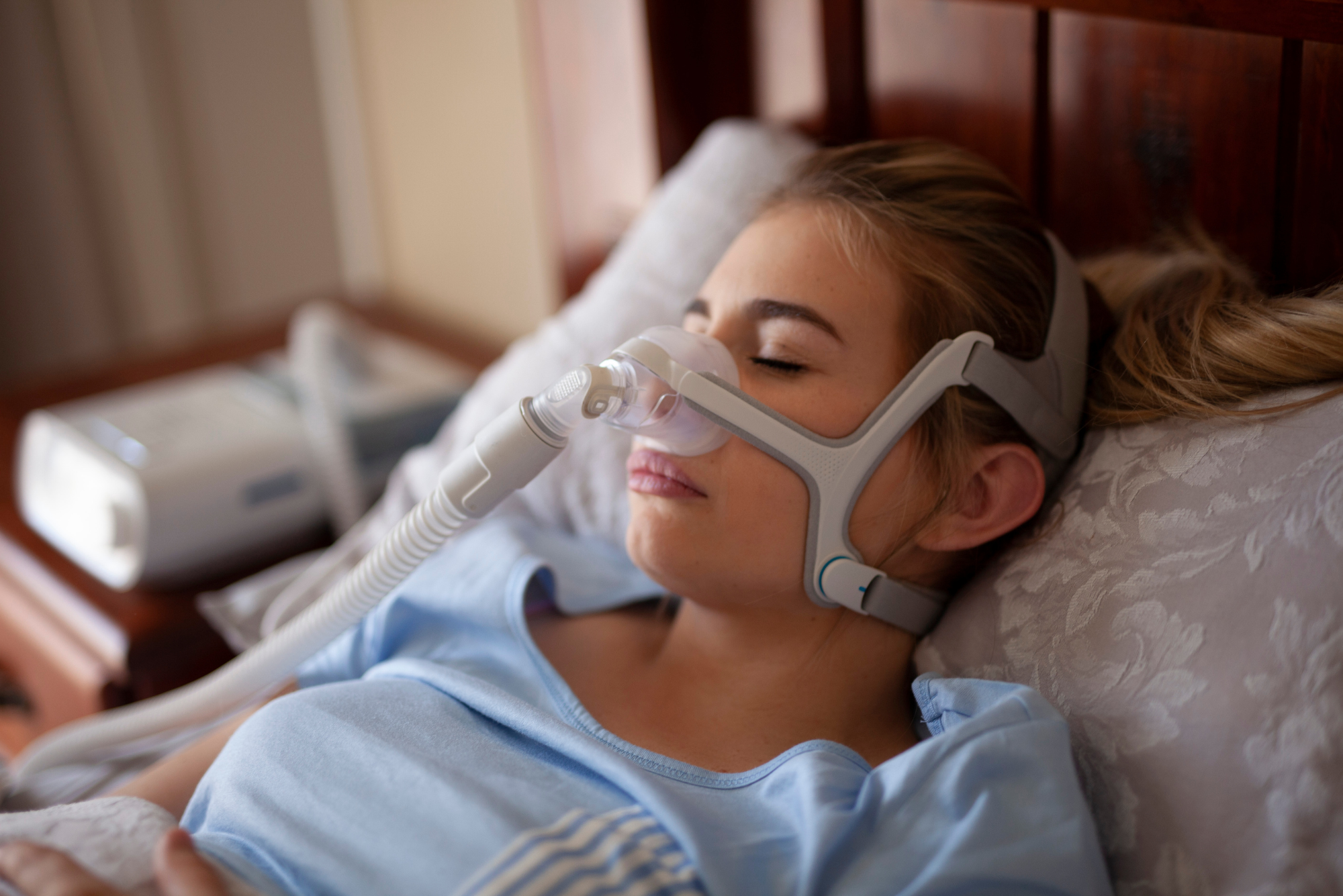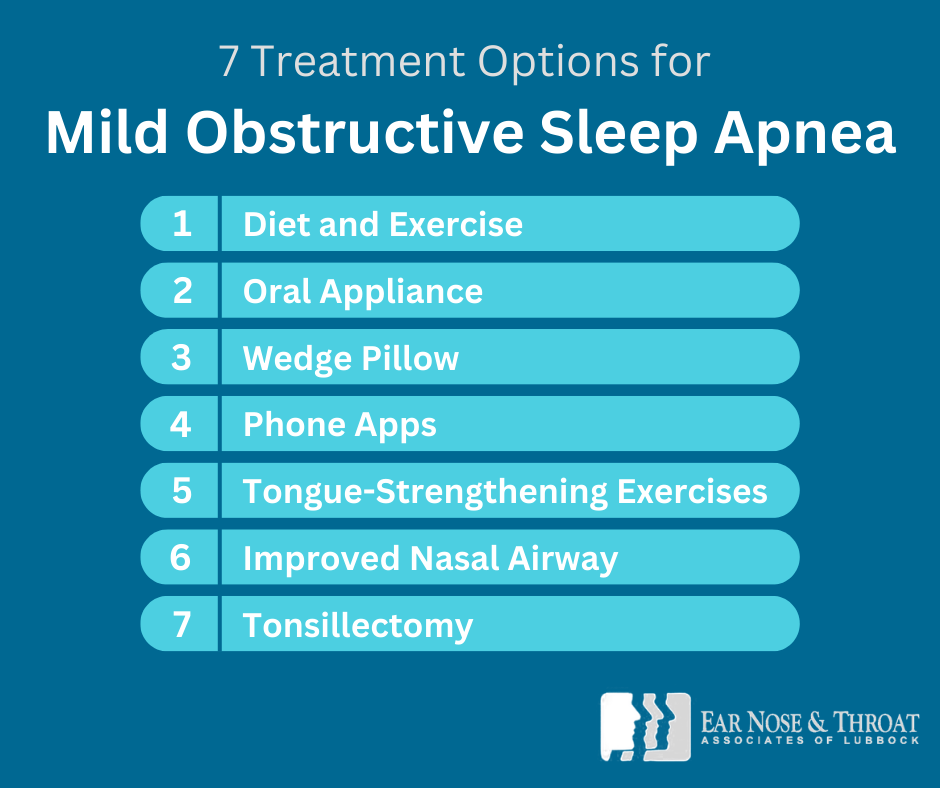7 Treatment Options for Mild Obstructive Sleep Apnea

Once you’ve received a mild obstructive sleep apnea diagnosis, the next step is exploring your treatment options. Fortunately, obstructive sleep apnea is a well-known condition, and there are several ways to manage and even cure the symptoms.
Finding the best treatment for mild obstructive sleep apnea may seem overwhelming at first, but with the help of an experienced physician, you can find a solution that works for you.
In this article, we’ll review seven top treatment options for mild obstructive sleep apnea. But first, to help you understand each option and why it helps, let’s quickly review how obstructive sleep apnea affects the body.
What Is Mild Obstructive Sleep Apnea and How Is It Diagnosed?
Mild obstructive sleep apnea is a blockage of the airway that causes you to stop breathing temporarily multiple times per night while you sleep. It’s categorized as mild, moderate, or severe, depending on how many disrupted breathing episodes you experience per hour:
- Mild obstructive sleep apnea: 5–15 episodes per hour
- Moderate obstructive sleep apnea: 15–30 episodes per hour
- Severe obstructive sleep apnea: 30 or more episodes per hour
A doctor can diagnose mild obstructive sleep apnea with a sleep study — also called a polysomnogram — in a hospital lab or sleep clinic. These in-depth tests detect obstructive sleep apnea as well as other sleep disorders. Alternatively, you can opt for an at-home sleep test, which is a little less in-depth but more specifically geared toward diagnosing obstructive sleep apnea.
What Are the Benefits of Treating Mild Obstructive Sleep Apnea?
One of the primary benefits of getting treatment for mild obstructive sleep apnea is enjoying better sleep, which improves overall health. Additional benefits include:
- Less fatigue and lethargy
- More energy
- Better performance at school or work
- Healthier immune system
- Lower long-term risk of medical events like heart attacks and strokes
- Fewer short-term risks from severe daytime drowsiness, like accidents at work or while driving
- Improved mood
- Reduced snoring
In general, people who get better sleep are healthier and happier. Getting treatment for even mild obstructive sleep apnea is an effective way to improve your overall well-being, whether you’re awake or asleep.
7 Treatment Options for Mild Obstructive Sleep Apnea
Sleep apnea isn’t something to ignore, so if you’ve received a diagnosis, it’s important to get treatment. Untreated sleep apnea can be quite dangerous, both in the short and long term.
Fortunately, there are quite a few treatments for mild obstructive sleep apnea that can help you find relief.

Treatment #1: Diet and Exercise
If a person is overweight, they’re more likely to have extra tissue around their throat and airway. When their muscles relax during sleep, this extra tissue can put pressure on the airway and block airflow to the lungs.
Losing a few pounds through a healthy diet and regular exercise can help many people reduce the excess tissue that presses on their airway. Since exercise also improves muscle tone, it can help keep the muscles around the airway from relaxing so much during sleep.
While it requires commitment and hard work, exercising regularly and maintaining a healthy diet can produce real results. According to Harvard Health Publishing, losing just 10% of your body weight can significantly reduce sleep apnea symptoms. In some cases, losing a considerable amount of weight may even cure sleep apnea completely!
Treatment #2: Oral Appliance
Another treatment for mild obstructive sleep apnea is an oral appliance from a dentist. With mild obstructive sleep apnea, a small adjustment to your jaw and airway can be enough to make a difference. Oral appliances resemble a mouthguard, and they cause mild forward jaw movement to keep your airway open while you sleep.
If you’re interested in oral appliance therapy, talk with a sleep specialist and a knowledgeable dentist. They’ll help determine whether this option is right for you.
Treatment #3: Wedge Pillow
For many people, sleeping on their back worsens sleep apnea symptoms. However, even if you know this and try to sleep on your side, it’s not always easy to keep yourself from rolling onto your back.
Fortunately, several products can help you maintain a more favorable position while you sleep.
For example, a wedge pillow is a specialty pillow that keeps you from sleeping flat on your back. Similarly, we’ve seen a wearable collar- or belt-like device you can position around your neck or chest that gently vibrates if you roll onto your back during sleep. Or, you find t-shirts that have a pocket for a tennis ball sewn onto the back to keep you on your side while you sleep.
Treatment #4: Phone Apps
Certain smartphone apps can also help relieve symptoms of obstructive sleep apnea by alerting you when you roll onto your back, snore, or have low oxygen levels. These apps may help you change your sleep habits with gentle watch vibrations or mobile notifications.
Treatment #5: Tongue-Strengthening Exercises
A new treatment for mild obstructive sleep apnea called eXciteOSA is a type of daytime therapy. This device is a simple mouthpiece you wear for 20 minutes daily.
The mouthpiece stimulates your tongue with exercises that tone and strengthen it. Over time, it retrains your tongue to stay in position overnight while you sleep.
The eXciteOSA device pairs with an app that allows you to control the intensity of the stimulation and get reminders and notifications about your therapy sessions.
Though the eXiteOSA device might be the easiest form of exercise, you can also perform beneficial oropharyngeal exercises without external assistance.
Treatment #6: Improved Nasal Airway
If you have a nasal obstruction blocking airflow through your nose, it could be causing or worsening your sleep apnea symptoms. To address this issue, an ENT doctor can evaluate your nasal passages and determine what’s causing the obstruction. Then they’ll be able to provide the appropriate treatment.
Clearing a nasal airway obstruction allows more air through the nose, which indirectly causes less obstruction.
Treatment #7: Tonsillectomy
Sleep issues are one of the main symptoms of enlarged tonsils. Removing your tonsils with a procedure known as a tonsillectomy can provide much-needed relief from nighttime symptoms. In some cases, it may cure mild obstructive sleep apnea.
If you and your ENT decide to proceed with a tonsillectomy, they can help you prepare for the procedure and answer any questions you have.
Final Thoughts on Treatments for Mild Obstructive Sleep Apnea
With so many treatment options for mild obstructive sleep apnea, it’s not always easy to know which one is best for you. Seeing a sleep specialist and an ENT doctor can help you determine what’s causing your sleep apnea and which treatments will help you sleep better!
Dr. Cuthbertson is a physician at Ear Nose & Throat Associates of Lubbock. He joined the team at ENT Lubbock from Houston, where he was chief resident of the prestigious Bobby R. Alford Department of Otolaryngology at Baylor College of Medicine. He is board certified in Otolaryngology and Head & Neck Surgery and has quickly built a reputation, not only as an extremely skilled surgeon, but as an approachable and compassionate clinician adept in the newest standards and technologies. Learn more about Dr. Cuthbertson.
Categories:








